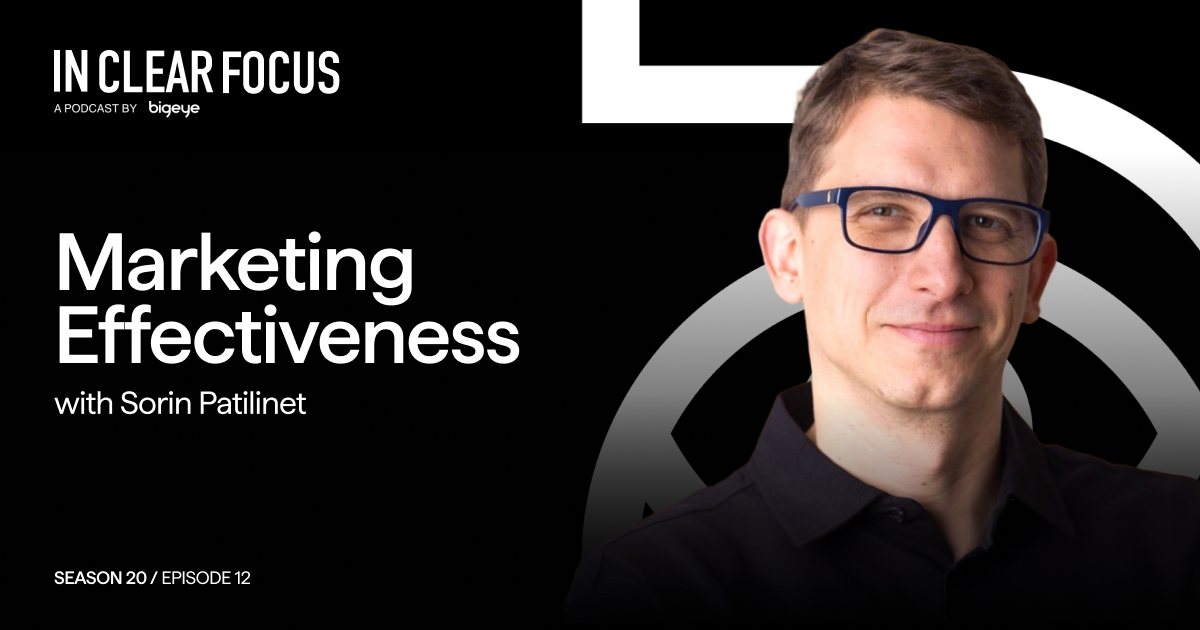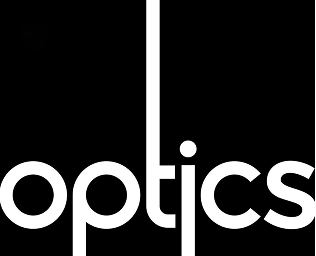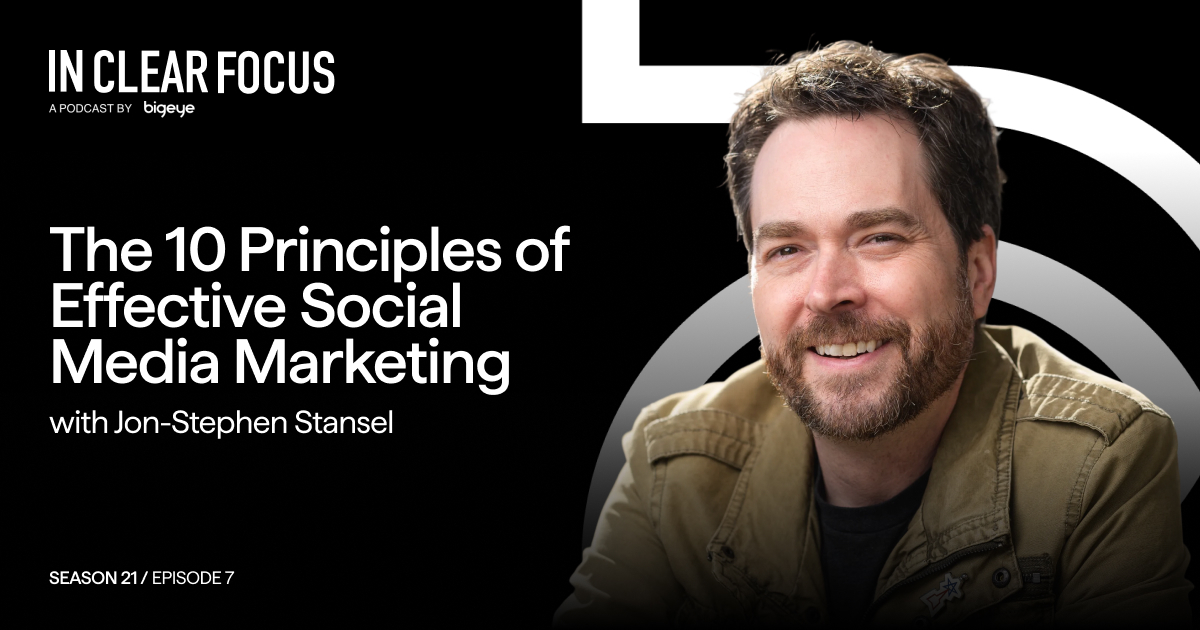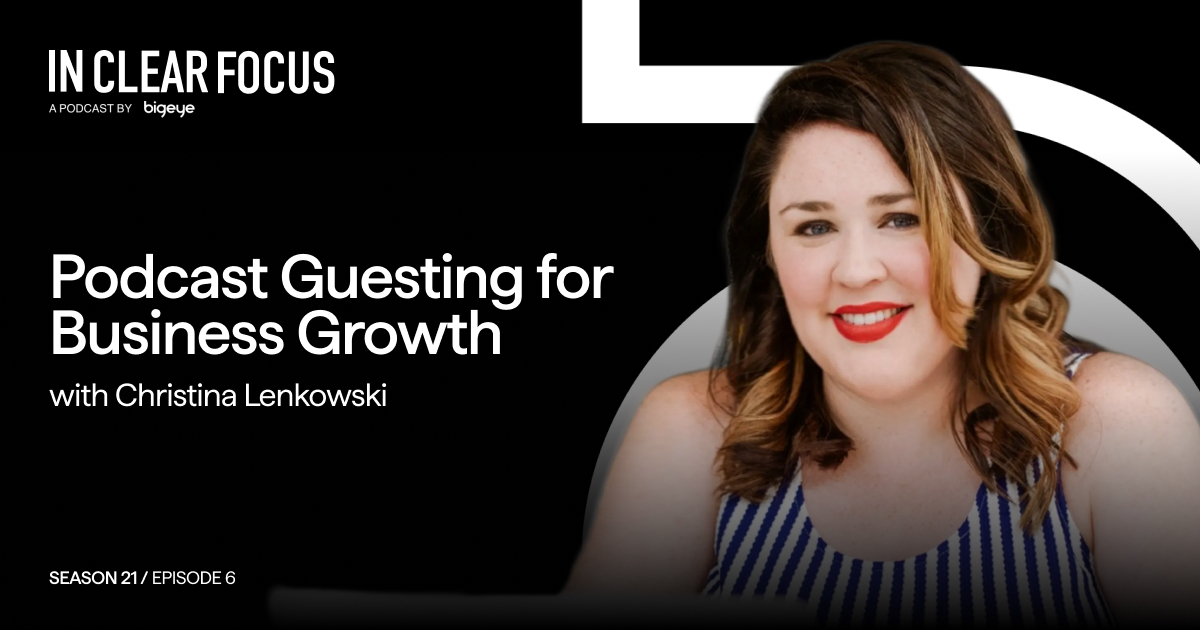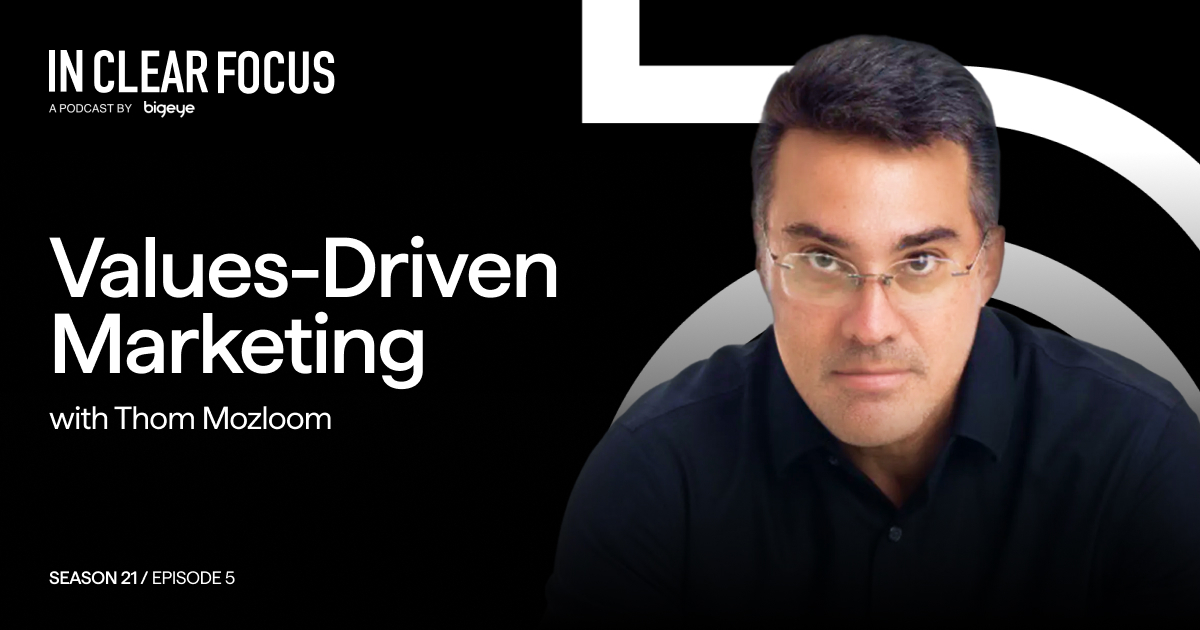IN CLEAR FOCUS: Sorin Patilinet of PepsiCo and author of “Marketing Effectiveness” shares his scientific approach to brand growth. Sorin explains why marketers must look beyond just advertising to all levers of effectiveness—from pricing to packaging. He introduces his Engineering Marketing Framework, discusses why brands grow through penetration, not loyalty, and explores the balance between creativity and analytics. Hear Sorin’s evidence-based principles for creating sustainable brand growth
Episode Transcript
Adrian Tennant: Coming up in this episode of IN CLEAR FOCUS
Sorin Patilinet: I’m suggesting frameworks, I’m suggesting ideas and metrics because that’s how I’ve seen successful brands thrive, by looking at marketing holistically and not just pointing one lever that they are busy with that week.
Adrian Tennant: You’re listening to IN CLEAR FOCUS, fresh perspectives on marketing and advertising produced weekly by Bigeye, a strategy-led, full-service creative agency growing brands for clients globally. Hello, I’m your host, Adrian Tennant, Bigeye’s Chief Strategy Officer. Thank you for joining us. Marketers today face mounting pressure to prove their value. With tightening budgets, demonstrating measurable business impact has become essential. Yet many marketers struggle to move beyond simple ROI calculations to demonstrate true effectiveness across their entire strategy, from product development and pricing to media planning and creative execution. Our guest today brings a unique perspective to these challenges, combining an engineering background with close to two decades of experience in marketing effectiveness, working at some of the world’s largest consumer brands. Sorin Patilinet currently serves as Global Marketing Effectiveness Executive at PepsiCo, but was previously with Mars, where he developed innovative measurement systems that earned industry recognition from organisations such as the Association of National Advertisers and the World Federation of Advertisers. Born in Romania and trained as a telecommunications engineer, Sorin transitioned successfully into marketing and has since become a sought-after speaker at industry events, including the Cannes Lions, and Sorin is a guest lecturer at The Wharton School. Sorin is also the author of this month’s Bigeye book club selection, “Marketing Effectiveness: Applying Marketing Science for Brand Growth,” published by Kogan Page. In his book, Sorin argues that effectiveness must encompass strategic, evidence-based decision-making across all marketing activities. To discuss how marketers can apply scientific principles to drive sustainable brand growth, the intersection of creativity and analytics, and the future of marketing in the age of AI, I’m delighted that Sorin is joining us today from Brussels, Belgium. Sorin, welcome to IN CLEAR FOCUS.
Sorin Patilinet: Thank you for having me, Adrian. It’s a real pleasure.
Adrian Tennant: Sorin, what inspired you to write your new book, “Marketing Effectiveness”?
Sorin Patilinet: I’ve been very active online and at various events, trying to learn more and understand a bit more to make better decisions in my career. And I’ve been observing that the majority of the discourse in marketing effectiveness is led by either academics, people like Byron Sharp, Mark Ritson, or other professors. Then you have agency people, Les Binet for example, and also you have research organizations that are mostly focused on communication. I can name Kantar here, Ipsos, System1. And what’s missing from this conversation is the voice of the brand, the voice of the advertiser, which has a more repeatable experience with the practices that each of those three parties are trying to convey. My book is building on their strong insights but providing a practical example and a practical way of handling those extremely useful theories into the real world. Let’s say when the CFO calls on Friday evening and says “You need to cut your budget by 25%!”
Adrian Tennant: Well, before we get into the details of the book, you mention attending something called the “Night of Ad Eaters” in your native Romania after the fall of communism. Can you tell us a little bit about that experience and how it influenced your path from engineering to marketing?
Sorin Patilinet: I’m super excited about that event. And the reason why I’m super excited now is because I realized that this event is happening in Europe this year, and I will join one of those sessions later in November and actually meet the founder, Jean-Marie Boursicault, who I’ve gotten in touch with. What is the Night of Ad Eaters? It’s a weird concept. You imagine yourself going into a cinema room at 7 p.m., let’s say, and you are there until the morning watching ads with some breaks, but mostly watching ads, ads from all over the world, beautiful ads, emotional ads, ads that allow you to discover brands, cultures and emotions. And for those who have lived through an oppressive regime, like the communist one, back in the 80s in Romania, there were no real international brands. It was like everybody was dying for a Pepsi or like a Snickers bar, but they were not so easy or almost impossible to find. I was very young, I don’t remember too much out of that, but I do remember when the communist regime fell, how everybody around you was obsessed with the Western culture, and how everything that we wanted was to drink a Pepsi and eat some chips. Because we did not have that experience as kids. But of course, distribution did not come immediately. What was there immediately was the Night of Ad Eaters. So that’s how I discovered international brands. That’s how maybe I was primed to think a bit more global than my initial upbringing. And I think that that’s how I fell in love with marketing.
Adrian Tennant: You believe that marketing effectiveness is different from advertising effectiveness. Sorin, can you explain this difference and why it matters?
Sorin Patilinet: In my view, we are a bit blind in the way we approach marketing effectiveness. And I was thinking a lot, “Why are we simplifying things when marketing effectiveness is much more complex?” One, I think it’s the scope of the marketing department, which in large organization has eroded in recent years due to specialization. And slowly, marketeers are becoming ad makers because pricing is no longer under their remit, because product placement in store is in the sales team, or because promotion is something that, again, the key account team is negotiating. However, I don’t think that we should only talk about advertising effectiveness. Numerous MMM studies have shown and are publicly showing that for most brands, communication or advertising media is responsible for anywhere between 0 and 10, 15% of the sales annually. So it’s clearly not the main driver of the brand. Physical availability is there, the fact that you’re using that brand is an even bigger element in driving effectiveness. Yet, however, we simply only obsess about ads … and we only obsess about which channels those ads are placed on. So my entire idea with this book was to elevate the conversation and to make marketeers think broadly, holistically about marketing effectiveness. To think about how they measure the effectiveness of their strategy, their positioning, their targeting, how they measure the effectiveness of pricing, of their product, of their distribution, and last but not least, about their effectiveness of their communication. I’m suggesting frameworks, I’m suggesting ideas and metrics that provide a holistic way, because that’s how I’ve seen successful brands thrive. By looking at marketing holistically and not just pointing one lever that they are busy with that week.
Adrian Tennant: Well, in your book, you introduce something you’ve dubbed the Engineering Marketing Framework. Can you explain what the EMF is and how it works?
Sorin Patilinet: The EMF is my attempt to bring structure into this process of thinking holistically about marketing effectiveness. I was surprised while researching for the book that 9 out of 10 CEOs of the largest market cap companies in the world are engineers. And if Jeff Bezos would have not disappeared from the CEO role from Amazon, they would have been 10 out of 10. I don’t think that that’s by luck. I think there is something about the way engineers think. I think there is something about the processes and the systematic way of approaching problems that makes successful leaders. Because, I’m assuming that part of the success of those companies is the performance of their CEO. So I’m trying to bring engineering principles, structure and data-driven marketing in a holistic way across the multiple levers of marketing effectiveness. And that’s what’s the engineering marketing framework.
Adrian Tennant: Well, you write about how brands really grow. Some listeners might be surprised to learn that it’s not necessarily through customer loyalty. Sorin, can you explain?
Sorin Patilinet: My experiences have been influenced significantly by the thinking of Ehrenberg-Bass and Byron Sharp. Their book, How Brands Grow, was fundamental 14 years ago, I still remember that moment, in changing my way of thinking from the traditional way of marketing to a more modern and scientific way of marketing. And the thesis in that book is that brands grow through attracting light buyers and non-buyers of the brand, because simply there are much more of those people than by growing through simply increasing the frequency of purchase of existing buyers. With almost no exceptions, this rule is valid, and I’ve seen it played out for most of the brands that I’ve been involved in. It’s not that loyalty doesn’t exist, it’s just that if you look at the hundred buyers of your brand, let’s say one or two are extremely loyal and only buy that brand. And if you make them buy twice more, you will not grow that much. Then if you convince 10 other people to try at least once your brand. I think it’s a matter of thinking broadly about who’s your target, what’s your category and how can you expand. It’s always about expanding the category because, just by talking to the same people it simply doesn’t work. And I’m trying in the book to play devil’s advocate a little bit. I’m looking at airlines and hotels and trying to understand why they are investing so much in loyalty programs and why we are also quite convinced that they sort of work. But I would love to be able to access data from an airline to see really, is it the loyal buyers that are driving most of their profit or in evolving into new markets, evolving into new offers and attracting maybe new buyers into the brand? I think it’s a fascinating topic.
Adrian Tennant: Well, it’s certainly interesting that you place research at the centre of the book, really. But creativity also plays a significant role in your framework. Sorin, how do you balance the art of marketing with the science?
Sorin Patilinet: My experience at Mars that lasted close to 14 years was in a central role that was dubbed the Center of Expertise for Creative Excellence. And my role was to help marketeers better understand what drives creative effectiveness. Measure it thoroughly and then inform future developments. And we’ve developed amazing tools. We’ve deployed the very advanced analytics. And there were still some cases when even though the tool told us the “ad is great,” in the market it bombed. We simply acknowledge that. We simply understood that advertising or creativity is a mix of art and science, and we tried to dial up science as much as we could, looking into neuroscience, understanding how attention works, how emotions work, how cognitive processes work. But we’ve also acknowledged that there will always be, let’s say, a 10%, if not more, of unexplained. In fact, if you think of research, and research is my background, I have not seen research that says with 100% certainty, “You need to go in direction A.” Research is always about probabilities. It’s always a likelihood that it mostly will be like that, but in some weird cases, it will not be like that. Snickers’ “You’re not you when you’re hungry” is the best example for me here. It was a campaign that ran for years and years, a campaign that always failed testing, simply because the construct of the communication was not very clear from the guidelines that we’ve developed. Branding was present only in the last frame. We know that branding needs to be brought in earlier in the process. And for those reasons, the ad was completely failing. However, in market, it did perform extremely well. And we still don’t know exactly why. But at Mars, we’ve kept that construct. We’ve developed new executions using the same platform. And I think it’s one of the evergreen campaigns that is currently under the radar of many other companies to try to decode what made it so successful.
Adrian Tennant: That’s fascinating. In your book, you also discuss common myths about media effectiveness. Sorin, what’s one myth that you think is particularly damaging for marketers?
Sorin Patilinet: So one of the myths that I’ve expanded on in the book was our passion with celebrating our brand’s anniversary. I don’t think there’s a day that passes that my LinkedIn is not filled with “This brand is now 100 years old” and “This campaign is like 10 years old.” And sometimes the message of those ads that go through paid media sometimes are not really about the brand, but they’re really about the celebration. So we’re advertising celebration and not the distinctive assets of the brand. So I think the myth here is that you should always focus on your brand’s core proposition. Use your distinctive assets and worry less about other people, how they celebrate your history. There is some element of heritage that can always be leveraged, but this is not as important as the real value that that brand will bring to the consumers today. So I would say focus on today than focusing on your 55-year-old history.
Adrian Tennant: Let’s take a short break. We’ll be right back after this message.
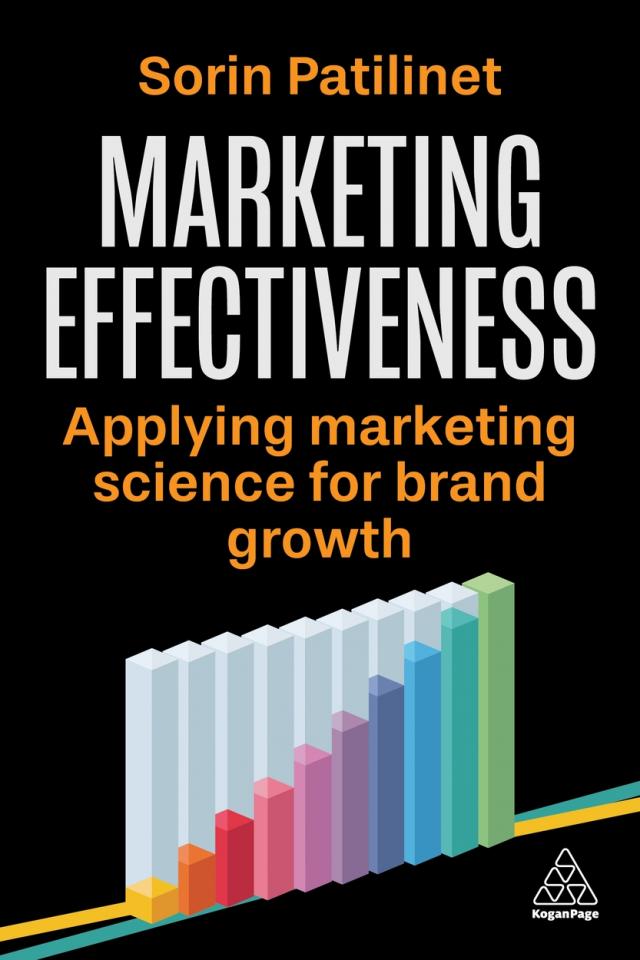 |
Sorin Patilinet: Hello, I’m Sorin Patilinet, the author of Marketing Effectiveness: Applying Marketing Science for Brand Growth published by Kogan Page.
Drawing on my over 20 years of experience, I reveal how marketers can bridge the gap between creativity and analytics to drive sustainable growth. Whether you’re a mid- to senior-level marketeer facing pressure to deliver quantifiable results, or someone looking to integrate advanced measurement into your marketing strategies, my book provides practical frameworks and real-world examples from brands like Snickers, Unilever’s Dove, and M&M’s. You’ll discover how to leverage neuroscience or machine learning to deepen customer understanding, navigate AI’s evolving role in marketing, and lastly, develop the skills needed to thrive as a modern marketeer. As an IN CLEAR FOCUS listener, you can save 25% on Marketing Effectiveness when you order directly from KoganPage.com. Just enter the exclusive promo code BIGEYE25 at checkout. Shipping is always complimentary for customers in the US and the UK. I hope my book helps you apply marketing science to create measurable success and elevate your marketing career. Thank you! |
Adrian Tennant: Welcome back. I’m talking with Sorin Patilinet, Global Marketing Effectiveness Executive at PepsiCo and the author of the Bigeye Book Club selection for October, “Marketing Effectiveness: Applying Marketing Science for Brand Growth.” Sorin, you argue that packaging is one of the most undervalued areas of brand communication, yet marketers continue to change it. What’s your advice on packaging effectiveness?
Sorin Patilinet: Don’t change the pack would be the number one advice! I’ve changed packs a lot. I’m guilty. I started my career in British American Tobacco in a company that basically had no ways of communicating with the consumers apart from, at that time, 15 years ago, packaging. So we were in love with limited edition packs, designing, using all our creativity to basically create designs and things that will stand out, but without really realizing that most of them were confusing our existing buyers, who were not finding their product on the shelf. I remember we were always using claims like “New pack, same taste” and stuff like that, which became like overarching themes of our communication. I don’t think in everything that I’ve seen, in all the data I’ve seen so far, that except for legal reasons, you should change your packaging. We get bored of our packaging, which is, to be honest, probably our number one communication vehicle in, let’s say, consumer packaged goods. We get bored of that packaging much sooner than our customers are getting bored of that font or that visual or anything else. And there are numerous examples today of brands that came back after a packaging design. So I think good advice would be just focus your time on better understanding your consumer rather than changing the pack and then doing research to explain yourself why you need to change that pack.
Adrian Tennant: Very good point you make. As marketers, we’re much closer to all of our distinctive assets in particular. I think there was a recent report that suggested we might actually think our assets are way more distinctive than real consumers do.
Sorin Patilinet: Absolutely. I think we are obsessed with our communication. We’re obsessed about our packaging because we see it every day. And we also, going back to your question on the myths, another myth is that we need to change creative every second week because people have seen that creative and they can’t stand it anymore. I mean, I’m going back again to Mars. Mars is using for M&M’s the same Christmas creative for years and years and years. There’s no signs of wear out. It performs extremely well. And it performs extremely well because, A, people don’t get bored of a funny story and they would like to watch it again and again. And B, we are the ones who get bored and we are the ones who need something else to do rather than spending time to really understanding of consumers. I’m not saying here that we should completely lie on the beach and forget about our brand. I think we should spend more time to understand our consumers because that’s what I think we are lacking.
Adrian Tennant: Well, perhaps not too surprisingly, artificial intelligence features prominently in your book as the future of marketing. Sorin, how do you envision AI impacting the measurement of marketing effectiveness?
Sorin Patilinet: AI is definitely here. It’s not impacting the future, it’s impacting the present of marketing. And when it comes to measurement, AI has impacted also the past. I mean, for the last years, I’ve been using a lot of machine learning, AI models to understand elements like, for example, in facial recognition research, when you expose respondents of a research to your ad, you use AI to understand from that visual image of the face what kind of emotions are expressed. That’s AI. You use AI in modeling to improve the analytics. You use AI in image recognition to understand how much your brand is present on screen during the entirety of, let’s say a sponsoring game, football game. So AI is everywhere. I think with generative AI, it has become really front and center and everybody is engaged with this future. I wish I’d know how AI and the story of AI and marketing will unfold, but I think we’ll have to wait and find out. My advice to anyone would be to try to get as many experiences, real-life experiences, before trying to do everything with a chatbot because, there will be a time for that and let’s not hurry things.
Adrian Tennant: I’m curious if you’ve done any work with synthetic data, whether that’s synthetic focus groups or synthetic quant studies – that you can talk about?
Sorin Patilinet: Absolutely. Synthetic data was a passion of mine, I think almost two years ago. And going back to the book, I’ve recognised that I’m not an expert in each element and each chapter of the book. And that’s why I’ve invited friends, industry experts, to talk about those topics in particular. And I’ve invited John Lombardo from Evidenza in the research chapter because I felt that synthetic research and the work they’re doing could be one of the areas where research will head towards. Now, I’ve known him for several years and I’ve supported his endeavor with Evidenza from day one, I would say. We’ve looked at how we can run faster, qual research and quant research as well. We’ve looked at understanding difficult-to-understand audiences that predominantly are not easy to get on a focus group. And I can’t share too much details of that, but I was blown away about the capability. I think when you don’t have access to respondents, it’s a fantastic way of complementing your gut feel. I think the technology will only get better, allowing you to go deeper into conversations with the target audiences that you’ve created. It’s a fascinating topic and I can’t wait to see the next evolutions in that.
Adrian Tennant: It’s certainly a very rapidly evolving area. I want to go back to the importance of how brands grow. You argue that proven marketing science principles like Double Jeopardy still need to be retrained to employees every year, even to those who are experienced marketers. Why do these principles generally face resistance, do you think, within large organisations?
Sorin Patilinet: I don’t know because all the organizations I’ve worked in embraced those concepts from the start. Both PepsiCo and Mars were very strong on data analytics, on embracing marketing science and the works of Byron Sharp. However, I felt that there was, with years gone by, there is a sort of an erosion of understanding. yes you get trained but every year that passes you get probably bored about applying the same tactic and then you start asking whether the opposite is not true and you may be doing that because you apply like the laws of growth and your brand is not growing. And then you start to question the laws and not the execution or the quality of the message. So I think especially in those large companies where I was lucky to be part of, the need to have regular yearly refreshers on new data that show the entire marketing department that those principles, those rules are still valid, even with the growth of D2C, even with the growth of e-commerce. was a big priority for me. So I’m still surprised that those insights are not permeating into the academic space a hundred percent. I think there is a gap there, but maybe that’s something for the guys in Australia to figure out how to spread that message better.
Adrian Tennant: Well, the Ehrenberg-Bass folks are pretty smart when it comes to spreading their message, that’s for sure. I am curious about one other thing. You’re in a unique position to have a perspective on the rise of retail media. We’ve noticed that a lot of working media dollars are going towards these lower-funnel tactics. What’s your perspective on retail media’s kind of pull for CPGs in particular?
Sorin Patilinet: Retail media is one of the priorities that I have in my current role, because I think as an industry, we need to codify how can we build brands using retail media. So far, I don’t think that we’ve created a model in which you could build brands without traditional or like long form video kind of formats that create that kind of, let’s say, upper funnel impact. But I think if retail media will continue to grow at the pace it’s growing right now, it will need to answer that question. “Can you grow a brand using just retail media dollars?” If not, I think the growth will be potentially decelerated and there will be another spread of dollars across numerous partners and offers in the market. Something similar to what has happened a couple of years ago with programmatic video and programmatic display. And that doesn’t help because, that creates a lot of fragmentation, that creates an impossibility to basically build reach and to know whether you’ve built that reach of your campaign. So, I think it’s a winner takes all. Whoever comes up with a retail media model that helps build brands from scratch, that player will be the winner, I think.
Adrian Tennant: Looking ahead, what trends do you expect to see in marketing effectiveness over the next few years?
Sorin Patilinet: So during the research of the book, I built the marketing effectiveness framework or the Engineering Marketing Framework. And I’ve kept it at a very high level because I strongly believe that the way you apply that framework to every organization depends very much on the culture of decision making in that organization. So I think marketing effectiveness won’t have in the future a single answer, but will actually have more answers than probably we would want. Because irrespective if you’re selling in the same category, through the same channels, potentially to the same consumers. The difference between a privately owned company and a listed company makes all the difference in the world in how you make decisions internally. And that’s only one element. The percentage of your sales that come from the top market, especially in the Western world from the US, also drives a different manner of decision making in the organization. Historical types of culture and artifacts in the organization are driving that change. So, I don’t think that the marketing effectiveness will converge. My hope is that we will align on some principles and that the execution will be very much dependent on the culture.
Adrian Tennant: Well, for readers of your book, you’ve also curated some interesting resources and made them available online. Can you tell us a bit about what purchasers of the book will gain access to?
Sorin Patilinet: When I started writing the book, I realized that writing a book in today’s age is a very fast, outdated process. I remember writing about AI was very daunting because I was like, OK, we’re in a stage of, let’s say, ChatGPT 3.5. Today, we’re in 5, and in two years from now, God knows what. I think that I’ve wanted to find a way for the book to be still relevant to those who will buy it in 1, 2, 3, 4, 5 years from now. So that’s why each chapter of the book has a QR code that links to a webpage, where I promise everyone to continuously update with links to podcasts, articles I’ve read and I found interesting, articles I’ve wrote and I think everyone should read who is interested in that topic. And some sort of living book beyond the paper that we printed in 2025.
Adrian Tennant: Great conversation. Sorin, if listeners would like to learn more about your book, “Marketing Effectiveness,” or read more about your work and marketing philosophy, what are the best ways of doing so?
Sorin Patilinet: The first way would be to go to marketing-effectiveness.com, which is my portal, and to find out how you can buy the book in your geography. It’s very much available through all large online and also physical bookstores. But to stay in touch, I would love to connect on LinkedIn. That’s where I spend my online time. That’s the easiest way to get access to my writing, to get access to me and to start the conversations. My main goal in writing the book was to be able to start new conversations with people I don’t know yet. And I think the fact that we’re having this conversation would have not been possible without me writing the book. Here it is, an example of one of the results of me writing the book. So thank you, Adrian, for having me.
Adrian Tennant: Well, thank you. And a reminder that IN CLEAR FOCUS listeners can save 25% on Sorin’s book, “Marketing Effectiveness,” when you order directly from the publisher, KoganPage.com, using the promo code BIGEYE25 at checkout. Sorin, thank you very much for being our guest this week on IN CLEAR FOCUS.
Sorin Patilinet: Thank you.
Adrian Tennant: Thanks again to my guest this week, Sorin Patilinet, the author of “Marketing Effectiveness: Applying Marketing Science for Brand Growth.” As always, you’ll find a complete transcript of our conversation with timestamps and links to the resources we discussed on the IN CLEAR FOCUS page at Bigeyeagency.com, just select ‘Insights’ from the menu. Thank you for listening to IN CLEAR FOCUS, produced by Bigeye. I’ve been your host, Adrian Tennant. Until next week, goodbye.
TIMESTAMPS
0:00: Introduction to Marketing Effectiveness
2:45: Inspiration Behind the Book
4:09: The Night of Ad Eaters: A Personal Experience
5:58: Distinguishing Marketing Effectiveness from Advertising Effectiveness
8:11: Introducing the Engineering Marketing Framework (EMF)
9:07: How Brands Really Grow
11:07: Balancing Creativity and Analytics in Marketing
13:29: Debunking Myths About Media Effectiveness
14:46: The Role of Packaging in Brand Communication
16:03: The Impact of AI on Marketing Measurement
20:57: Exploring Synthetic Data in Marketing Research
22:17: Reinforcing Proven Marketing Science Principles
24:10: The Rise of Retail Media in CPG Marketing
26:00: Future Trends in Marketing Effectiveness
27:35: Resources for Readers of the Book
28:47: Closing Remarks and How to Connect
